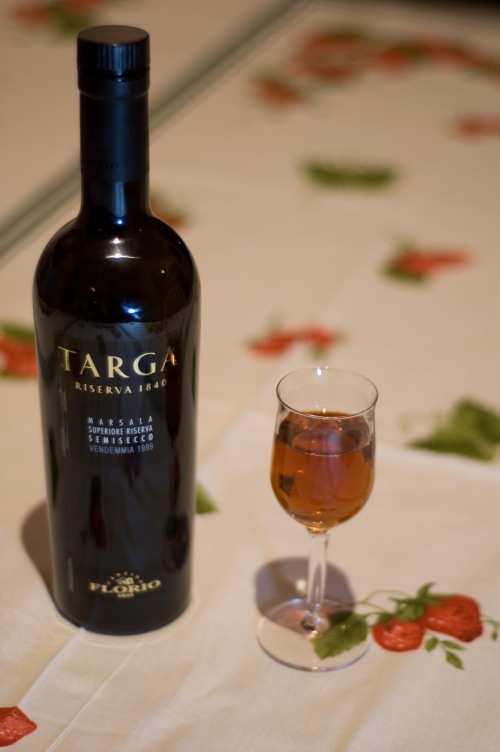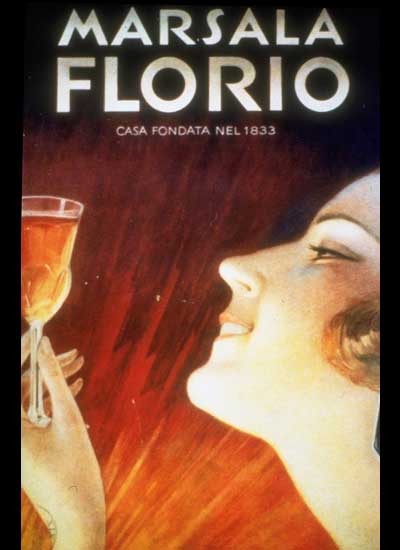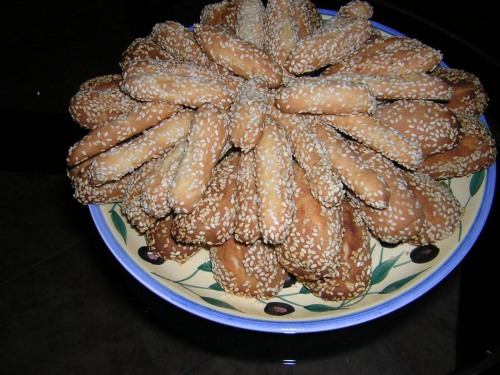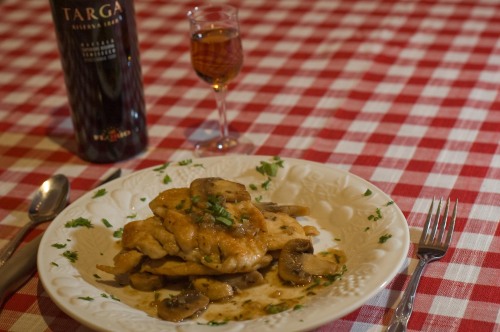
I can’t tell you the number of times that I’ve told someone that I live in Marsala, Italy, and they’ve responded, “You mean, like Chicken Marsala?” Another frequent response is, “Oh…like the cooking wine!” When we told a friend of my husband’s that we were living in Marsala, he exclaimed, “You’re living in the place that my favorite Italian dish is named for! If you live in Marsala, and want to eat Chicken Marsala at a restaurant, do you just order chicken?” So, for those of you who might be wondering the same things (I know you’re out there), let me put your pondering minds at ease.
Marsala wine is named for the city of Marsala. In 1773, an English sailor by the name of John Woodhouse landed at the port of Marsala due to poor weather conditions at sea. Upon exploring the area, he discovered that the local wine produced in the region had a flavor similar to the fortified Spanish and Portuguese wines, and thought that his fellow countrymen back in England would enjoy the flavor if it. Fortified wines, such as Marsala, Port, Medeira, and Sherry, have alcohol added to them before the fermentation process. This process kills the yeast, and leaves residual sugar behind, which results in a sweeter and stronger wine. Since alcohol is also a natural preservative, fortifying wine extends its shelf life, which made the Marsala perfect for Woodhouse to transport on the long sea voyage back to England.

Old Woodhouse Marsala Label
Marsala was such a big hit in England that Woodhouse returned to the city of Marsala in 1796 to begin mass producing and selling this fortified wine. In 1833, Vincenzo Florio bought land near the Woodhouse and Ingham (another English Marsala producer) estates, and began producing his own Marsala. Eventually, Florio purchased the Woodhouse firm, as well as others that had sprung up, including Ingham and Whitaker. Today, Cantine Florio is the oldest Marsala producer in existence, and remains one of the leading producers of the wine. It’s also only about ten minutes away from my house, which makes it very convenient for me J. FYI…Tours of Cantine Florio are available Monday-Friday, but reservations need to be made in advance for tours in English.

Vintage Florio Marsala poster - I have a print of this one hanging in my dining room.
Many Americans believe that Marsala wine is just a cooking wine. Not so. While it is used in culinary creations, here in Italy, it is often enjoyed as an apperitivo (appertif) before dinner, as well as a digestivo (digestive) after the meal. How a Marsala is savored often depends on its type. Marsala is made primarily from four white grape varietals, either solely or as a blend. These include Grillo, Catarratto, Insolia, and Damaschino. The red varietals of Nerello Mascalese, Nero D’Avola, and Pignatello may also be added in small amounts to achieve a specific color or flavor.
There are several classifications of Marsala, based on the color, age, and flavor or the wine.
Oro – has a golden color, resulting from omitting of mosto cotto (cooked grape must)
Ambra – has an amber color, resulting from the addition of mosto cotto
Rubino – has a ruby color, resulting from the addition of both white and red grapes, and no mosto cotto
Dolce (Sweet) – has more than 100 grams per liter of reduced sugarsFine – has minimal wood barrel aging, usually one year; typically used for cooking
Secco (Dry) – has no more than 40 grams per liter of reduced sugars
Semi-Secco (Semi-Dry) – has more than 40 grams per liter of reduced sugars, but less than 100 grams.
Superiore (Superior) – with a wood aging of no less than 2 years; traditional dessert wine, especially good with biscotti and hard cheeses
Superiore Riserva (Superior Reserve) – wood-aged for no less than 4 years; elegant dessert and sipping wine; pairs well with biscotti, fine pastries, nuts, and dried fruits.
Vergine (Virgin) – with a wood aging of no less than 5 years; excellent apperetif or with smoked fish and hard, medium-sharp cheeses
Vergine Riserva (Virgin Reserve)– wood-aged for at least 10 years; elegant sipping wine
Unfortunately, the only Marsala wines that are exported to the United States are the dolce and fine varieties. This is mostly because there is no demand for the more refined Marsala, since the majority of Americans think of Marsala solely as a cooking wine. I know that I sure did prior to moving here. Now, however, Marsala is one of my favorite drinks to savor either before or after dinner. I often enjoy it with sesame-seed coated Biscotti Regina (Queen’s Cookies), which I love to dunk into the Marsala, letting them absorb some of the wine, and then eat them. I know that hat may sound like sort of an odd idea to some of you. Dunking cookies in wine? Trust me, though, it’s quite yummy!

Homemade Biscotti Regina
So, now for the answer that I know you’ve all be waiting on pins and needles for. If you want to order Chicken Marsala at a restaurant in Marsala, do you just order chicken?
The answer my friends, is NO! Shocking, but true 😉 Pollo alla Marsalese (Chicken in the style of Marsala) does exist here, however Vitello alla Marsalese (Veal in the style of Marsala) is seen more often on restaurant menus. However, neither of them is quite as common as you might think. Menus here are predominately filled with pasta dishes and seafood. Meat items do make an appearance, but not always in the form of Chicken or Veal Marsala. When they do appear, the dishes are also considerately simpler and lighter than many of the versions that I’ve tasted in the U.S., in which the sauce is thick, and more gravy-like, or even has some cream added.
Below you will find my recipe for Pollo alla Marsalaese. The prosciutto isn’t really a traditional ingredient, but it was included in the dish at a restaurant that we visited when we first arrived here, and my husband, Jay, really liked it. So, now I sometimes include it for him. Feel free to leave it out, though. The herbs are also a personal addition. I just like the fresh burst of flavor that they impart in the sauce. Again, leave them out, if you wish. As for the Marsala itself, I have had this dish prepared with both the sweet and dry variety of Marsala. In my opinion, both are delicious, but I prefer using the sweet Marsala. It really is a personal preference, though. Try it with the sweet one time, and then with the dry another, and see which one you prefer. You may also use this same recipe to make Vitello alla Marsalese. Just swap the chicken for the same amount of veal scallopine.

My Pollo alla Marsalese
Pollo alla Marsalese
1 pound boneless, skinless chicken breasts, pounded or sliced into thin scallopine
1/2 cup all-purpose flour
Salt
Pepper
1/4 cup extra-virgin olive oil
8 oz. button mushrooms, thickly sliced
1 shallot, finely diced
3 slices prosciutto, cut into thin strips (optional)
2 tsp. fresh rosemary, finely chopped (optional)
2 tsp. fresh thyme leaves (optional)
1 cup sweet Marsala wine
2 Tbsp. unsalted butter
Season the chicken scallopine with salt and pepper. Put the flour in a shallow dish, and season with about 1 tsp salt, and a little pepper. In a 12-inch saute pan, heat the olive oil over medium heat until almost smoking. Dredge the scallopine in the seasoned flour, tap off the excess, and add to the pan. Do not dredge all of the chicken prior to cooking. Dredge them as you need them. Otherwise, the flour could get gummy, and the chicken will not brown well. You should be able to fit about 3-4 pieces in the pan. Do not put too many, or the chicken will simply steam, and not brown. Saute the scallopine, turning once, until golden brown on both sides, about 2 mintues per side. Transfer to a plate and keep warm.
Add the mushrooms to the same pan that you cooked the chicken in. Do not stir them or do anything to them for about 2-3 minutes. You want them to get a nice caramelizaiton. Once they have caramelized on one side, stir them, and add 1 Tbsp. unsalted butter, the shallots, prosciutto, and 1 tsp. of each of the herbs (if using). Season with salt and pepper, and saute about another minute more, or until the shallots have softened. Add the Marsala, and scrape any caramelized bits on the bottom of the pan. Bring to a boil, and reduce the mixture by about one third. (This is a very important step! If you do not reduce the sauce, you will taste the alcohol. I suggest that you taste the sauce immediately after you add the Marsala, just to know what it tastes like. Continue tasting it as it reduces so you can taste how much it changes.).
Swirl in the remaining 1 Tbsp. of butter, and replace the scallopine in the pan. Bring just to a boil, reduce the heat, and simmer 4-5 minutes. Stir in the remaining fresh herbs, and adjust seasoning with salt and pepper, if needed. Transfer the chicken to a serving platter, pour the mushrooms and sauce over the meat, garnish with fresh parsley, if desired, and serve.
For something different, I sometimes use this basic recipe and turn this into a pasta dish by using a bit more Marsala for simmering the mushroom mixture. After it has reduced, I then remove it from the heat, swirl in a couple of tablespoons of Mascarpone cheese, and toss the mixture with some Rigatoni pasta, and add the chicken scaloppini, cut into strips. I’ve also used shredded leftover roast chicken instead of the scaloppini. Garnish with chopped, fresh Italian parsley, a little grated Parmigiano-Reggiano, and serve. Buonissima!